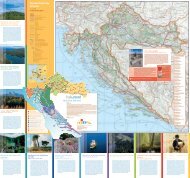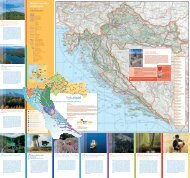Croatian Gastronomy - Nostromo
Croatian Gastronomy - Nostromo
Croatian Gastronomy - Nostromo
You also want an ePaper? Increase the reach of your titles
YUMPU automatically turns print PDFs into web optimized ePapers that Google loves.
02<br />
lamBs rEarEd<br />
on thE islands<br />
of thE northErn<br />
adriatic, and<br />
from thE hintErland<br />
of vElEBit,<br />
arE spit-roastEd<br />
in many rEstaurants<br />
found<br />
alonGsidE thE<br />
road.<br />
kvarner<br />
Frutti di<br />
mare and<br />
fish are a<br />
dominant<br />
feature in<br />
restaurants<br />
along the<br />
shores.<br />
the dormouse is the gastro-specialty of this region. Today,<br />
the uninitiated tend to look at them askance, but recipes<br />
for their preparation can be found as<br />
long ago as Apicius’ collection of recipes.<br />
Nowadays, their flesh is mostly fried or<br />
spit-roasted. The most delectable of all<br />
is a young dormouse cooked over charcoal,<br />
sometimes coated with corn flour.<br />
Older ones are prepared in goulash and<br />
served with polenta. Dormouse is served<br />
in Kastav, Liganj, Lovranska Draga...<br />
On Whit Sunday (one week after St.<br />
Michael’s Day, September 29th) when<br />
the hunting season opens the dormouse<br />
becomes a gastronomic delicacy of the<br />
first order.<br />
u d i č<br />
Salted leg of an older lamb or a sheep is<br />
hung to dry in the bora (north wind), and<br />
sometimes allowed to smoke for a brief<br />
period. On Cres, leg of lamb thus prepared<br />
is called udiè and is one of the<br />
lesser known pearls of <strong>Croatian</strong> rural<br />
gastronomy. The same method is also<br />
practised around Dubrovnik, particularly<br />
in Konavle.<br />
GroBnički sir<br />
Grobnièki sir, or cheese from the Grobnik range, is produced<br />
from milk of sheep which graze on the mountain meadows<br />
of Gorski kotar, in the villages above the Grobnik range.<br />
14 croatian <strong>Gastronomy</strong><br />
This large cylinder cheese does not come in any uniform<br />
shape since it is shaped by hand, without pressing. It can<br />
weigh up to 20 kg. This is a distinctly salty cheese, which is<br />
why in Rijeka they call it just that: salty cheese.<br />
c h E E s E s o f t h E<br />
K v a r n E r i s l a n d s<br />
Grazing on the north Adriatic islands is very distinct, and<br />
it yields a readily identifiable aromatic sheep milk. On the<br />
island of Krk, people produce a small cheese weighing less<br />
than half a kilo, locally known as formajela. Around Vrbnik<br />
it is usually spherical, while above Baška it is square. If not<br />
sold in its fresh form it is kept in olive oil for up to a year.<br />
On the islands of Cres and Lošinj, cheese is larger and usually<br />
with a higher fat content. Sometimes it is coated with the<br />
residue of olives which remains after the oil has been pressed out<br />
it is in this arEa that thE BEst scampi of thE<br />
adriatic arE cauGht and prEparEd.










